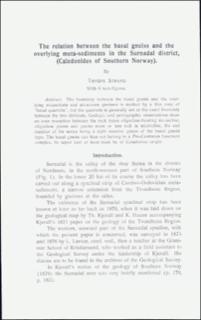| dc.contributor.author | Strand, Trygve | |
| dc.coverage.spatial | 14204 Stangvik | |
| dc.date.accessioned | 2020-08-26T12:42:28Z | |
| dc.date.available | 2020-08-26T12:42:28Z | |
| dc.date.issued | 1953 | |
| dc.identifier.uri | https://hdl.handle.net/11250/2674605 | |
| dc.description.abstract | The boundary between the basal gneiss and the overlying micaschists and micaceous gneisses is marked by a thin zone of \"basal quartzite\", but the quartzite is generally not at the exact boundary between the two divisions. Geologic and petrographic observations show an even transition between the two rock types oligoclase-bearing micaschist, oligoclase gneiss and gneiss more or less rich in microcline, the end member of the series being a light massive gneiss of the basal gneiss type. The basal gneiss can thus not belong to a Pre-Cambrian basement complex, its upper part at least must be of Caledonian origin. | |
| dc.language.iso | eng | |
| dc.relation.ispartofseries | NGU (184) | |
| dc.rights | Navngivelse 4.0 Internasjonal | |
| dc.rights.uri | http://creativecommons.org/licenses/by/4.0/deed.no | |
| dc.subject | PETROGRAFI | |
| dc.subject | OMDANNET BERGART | |
| dc.subject | GNEIS | |
| dc.subject | GRØNNSTEIN | |
| dc.subject | SKIFER | |
| dc.subject | KVARTSITT | |
| dc.title | The relation between the basal gneiss and the overlying meta-sediments in the Surnadal district, (Caledonides of Southern Norway). | |
| dc.type | Journal article | |
| dc.description.localcode | 35541 | |
| dc.source.pagenumber | 100-123 | |

